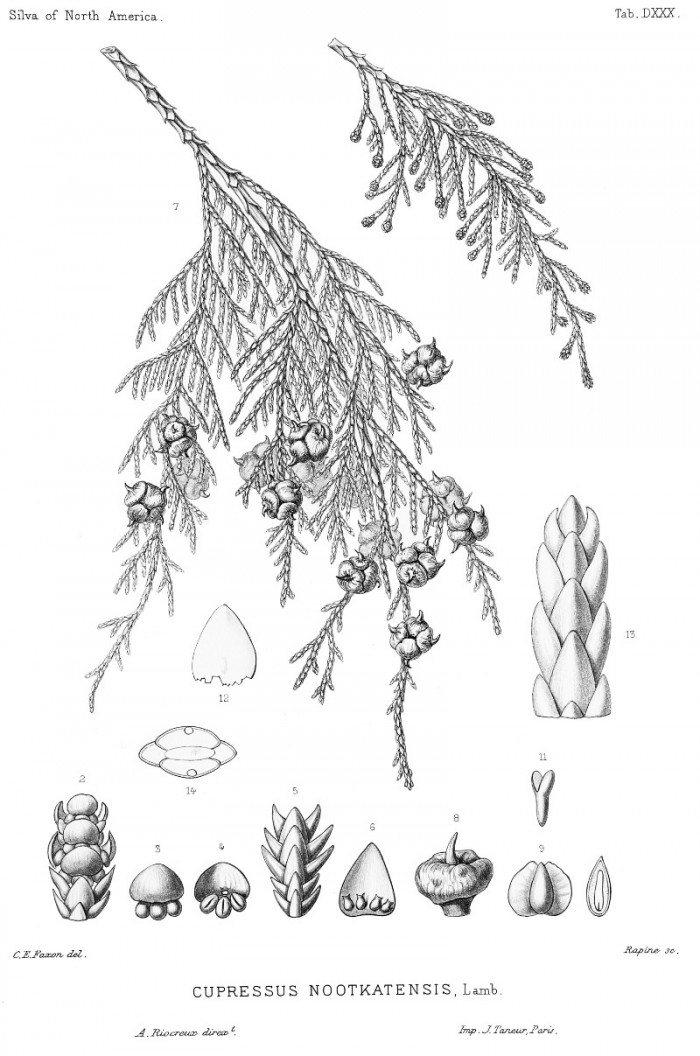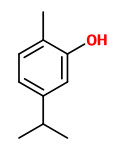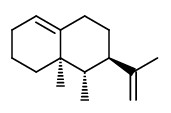Benutzer-Werkzeuge
Cupressus nootkatensis D. Don - syn.Chamaecyparis nootkatensis (D. Don) Spach; Xanthocyparis nootkatensis (D. Don) Farjon & D. K. Harder; Callitropsis nootkatensis (D. Don) Florin ex. D. P. Little - Cupressaceae
Alaska yellow-cedar, Nootka cypress, yellow-cedar, Nootka-Scheinzypresse, Nutka-Scheinzypresse, Alaska-Zeder
Monoecious evergreen tree to 40 m tall, native to the west coast of North America; branches tending to droop; bark thin, grayish-brown; wood sulfur-yellow in color; leaves malodorous when crushed, opposite, scale-like in 4 rows, bluish-green; staminate cones about 4mm long, ovulate cones up to 10mm long, globose, brownish and glaucous.
http://www.efloras.org/florataxon.aspx?flora_id=1&taxon_id=233500342
[Callitropsis nootkatensis, WTU Herbarium image collection, Burke Museum of Natural History and Culture, 2017] http://biology.burke.washington.edu/herbarium/imagecollection.php?SciName=Callitropsis%20nootkatensis
„The essential oil of Alaska cedar heartwood is known to contain compounds which contribute to the remarkable durability of this species. While previous research has identified several compounds, a complete description of this oil, which has a „burnt-grape fruit“ odor, has not been undertaken. In this research a profile of the oil is given in which the major components are identified by GC-MS, isolation and spectroscopic techniques. The major components of the steam distilled essential oil were identified as nootkatin, nootkatone, valencene, nootaktene, carvacrol, methyl carvacrol, nootkatol, and eremophil-1(10),11-dien-13-ol. In addition, it was found that the diethyl ether extract of the heartwood contained 1(10)-eremophilen-11,12-epoxide as a major component in addition to the compounds found in the steam distilled essential oil. 1(10)-Eremophilen-11,12-epoxide apparently does not survive the condition of steam distillation. Nootkatol, eremophil-1(10),11-dien-13-ol and 1(10)-eremophilen-11,12-epoxide have not been previously reported in Alaska cedar. Nootkatol is a known compound having been reported in other plants. However, eremophil-1(10),11-dien-13-ol and 1(10)-eremophilen-11,12-epoxide represent new chemical structures to science being described here for the first time.“
[Xiong, Yeping. „Essential oil components of Alaska cedar heartwood.“ (2000)]
Of 15 natural products isolated from essential oil components extracted from the heartwood of Chamaecyparis nootkatensis, „…nootkatone from Alaska yellow cedar was the most effective of the eremophilane sesquiterpenes against ticks (LC50 = 0.0029%), whereas the nootkatone grapefruit extract exhibited the greatest biocidal activity against fleas (LC50 = 0.0029%). Mosquitoes were most susceptible to one of the derivatives of valencene, valencene-13-aldehyde (LC50 = 0.0024%), after 24 h. “
[Panella, Nicholas A., et al. „Use of novel compounds for pest control: insecticidal and acaricidal activity of essential oil components from heartwood of Alaska yellow cedar.“ Journal of medical entomology 42.3 (2005): 352-358]
Essential oil components extracted from the heartwood of Chamaecyparis nootkatensis were evaluated against nymphal Ixodes scapularis in a laboratory bioassay and compared with N,N-diethyl-3-methylbenzamide (DEET). Nootkatone, valencene-13-ol, nootkatone 1→10 epoxide, and carvacrol had repellent concentration (RC)50 values in the range of DEET.
[Dietrich, Gabrielle, et al. „Repellent activity of fractioned compounds from Chamaecyparis nootkatensis essential oil against nymphal Ixodes scapularis (Acari: Ixodidae).“ Journal of medical entomology 43.5 (2006): 957-961]
The wood oil of C.nootkatensis contained nootkatene (50-60%), valencene (10-15%), carvacrol (5-8%), and nootkatone (2-5%).
[Fabian Laszlo, O Majestoso Oleo de Nootka tree, Laszlo Aromaterapia Ltda 2013]
http://laszlo.ind.br/campanhas/O_Majestoso_Oleo_de_Nootka_tree_Laszlo.pdf
A valencene synthase (CnVS) is only present in the heartwood, not in leaves or cortex, leading to nootkatone content in wood tissue of 1.1-1.6µg/g. The wood contained some di-isopropyl naphtalenes; main volatile compound of the cortex was nerolidol.
[Beekwilder, Jules, et al. „Valencene synthase from the heartwood of Nootka cypress (Callitropsis nootkatensis) for biotechnological production of valencene.“ Plant biotechnology journal 12.2 (2014): 174-182] http://onlinelibrary.wiley.com/doi/10.1111/pbi.12124/pdf
Carvacrol (7.1%) was the most abundant monoterpene in ethyl acetate extracts of the heartwood, followed by terpinen-4-ol (1.0%). Sesquiterpenes represented 56.8% of the total volatile composition, with valencene-11,12-diol (16.8%), nootkatol (10.6%), nootkatone (8.2%), nootkatene (2.7%), and valencene (2.6%). Tropolones present were hinokitiol (β-thujaplicin, 0.9%) and nootkatin (6.4%).
[Rick G. Kelsey, M. P. Gonz ́alez-Hern ́andez, Joe Karchesy, Sheeba Veluthoor. Volatile ter-
penoids and tropolones in heartwood extracts of yellow-cedar, Monterey cypress, and their
hybrid Leyland cypress. Annals of Forest Science, Springer Verlag/EDP Sciences, 2015, 72 (3),
pp.349-355] https://hal.archives-ouvertes.fr/hal-01284178/document
Cedarwood Alaska essential oil (steam distilled from fresh sawdust) combines spicy, aromatic and woody aspects with grapefruit notes, due to its nootkatene and nootkatone content. It is less camphoraceous and smoky, but stronger and longer lasting than regular Cedarwood EO (from Juniperus virginiana).
[Cedarwood Alsaka essential oil, Firmenich 967442, 2016]
https://www.firmenich.com/uploads/files/ingredients/marketing-sheet/perfumery/CEDARWOOD_ALASKA_EO_967442.pdf retrieved 2018-12-31
'Wood 49 Essential Oil' (Robertet) is a fraction of the essential oil from steam distillation of Alaskan Cypress with woody smoky odor.
https://perfumersupplyhouse.com/product/wood-49-essential-oil/

Sargent,C.S., The Silva of North America, vol.10, t.530 (1898) [C.E. Faxon]
http://plantgenera.org/species.php?id_species=1231059
Cupressus nootkatensis as Chamaecyparis nootkatensis
© Rolf Marschner (2010),
www.botanische-spaziergaenge.at



